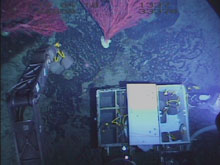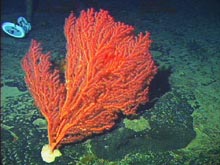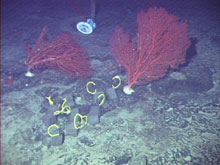
The manipulator arm on DSV Alvin lifts the bare basalt blocks from the bins and places them on the ocean floor at the top of Manning Seamount. Click image for larger view.
Recruitment and Larval Settlement of Deep-sea Corals
Lauren Mullineaux
Associate Scientist
Biology Department
Woods Hole Oceanographic Institution
Read more about the Deep-sea Diaspora (4 pages, 264k) and how species migrate from vent to vent.
Large coral colonies, both scleractinians (hard corals) and octocorals (soft corals, such as gorgonians), occur in patches on deep seamounts. In striking contrast to typical deep-sea communities, these coral communities are associated with abrupt topographic features, such as pinnacles or escarpments. The processes involved in their formation and persistence, however, are not well understood. Recent research suggests that some colonies may be hundreds, even thousands, of years old and that abundances of coral larvae are low. This suggests that new coral colonies might be rare. In fact, the location and species composition of an aggregation may be partly due to past events, as well as present environmental conditions. The rarity of recruitment into these ecosystems and the unusual longevity of the component species raise the possibility that they will be highly susceptible to disturbance. Natural disturbances on deep seamounts appear to be mild and infrequent, but anthropogenic disturbance is increasing rapidly as fishermen abandon over-fished coastal regions and migrate to deeper waters. The bottom-trawls used to fish the seamounts also remove the corals and their associated faunal communities. If the coral re-colonize only rarely, such trawling may cause long-term reduction in biodiversity and removal of habitat for juvenile fishes.

Sometimes called a "bubble gum" coral, the octocoral Paragorgia sp. has a large population at the top of Manning Seamount. The high density of corals could be a reliable source of larvae for the recruitment experiment. Click image for larger view.
We want to study how coral communities form and persist on deep seamounts. This research will help us to understand the dynamics of the component populations and their susceptibility to disturbance. To accomplish this, we must determine where and when communities form, how often they are re-colonized, and whether subsequent colonists are supplied by the local populations or immigrate from remote sources.
Last August, we used the DSV (deep submergence vehicle) Alvin to place a series of basalt (volcanic rock) blocks on the Manning Seamount summit in an area with dense colonies of Paragorgia sp. This year, we will use a remotely operated vehicle (ROV) to recover these blocks and check for the presence of newly settled Paragorgia. We will transport the tablets to the surface in individual compartments, further protected by an insulated box to avoid loss and thermal degradation of recruits. Samples will be preserved at sea in 80% ethanol and sorted later to the lowest taxonomic level possible. Species-level identifications of octocoral recruits are unlikely based on morphology. Specimens will be retained for future molecular genetic identification.

Several basalt blocks, placed in close proximity to two adult Paragorgia sp., provide a large surface area for recruiting octocoral larvae. Click image for larger view.
On this year's cruise, we also want to develop a protocol for aging individual colonies of different sizes. This procedure will generate a size-age relationship for this particular community. Since we have video images showing the size distributions of Paragorgia within this community, we can use this relationship to estimate the age-distribution of colonies. The age-distribution will be used to evaluate recruitment dynamics of Paragorgia in that community, answering specific questions such as: (1) is recruitment constant, or episodic; (2) when was the most recent recruitment episode; and (3) how long ago did the oldest colonies recruit?





















